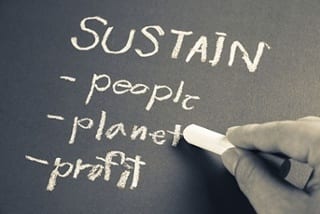What is the value added proposition for sustainability? For many years I have had the privilege of discussing sustainability with organizations across the country. Regardless of the group, be it a private company, municipality, higher education institution, or K-12 school district, communicating sustainability’s value proposition is at the heart of most discussions. This is a very important issue to address and helps shape organizations’ sustainability strategies. There are certainly a number of positive outcomes when establishments adopt sustainable practices. But before we answer the “how” we need to discuss the “why.”
For those of us who have successfully implemented sustainable strategies, our organizations have enjoyed a multitude of benefits in numerous categories. An early challenge in fostering organizational participation in sustainable strategies is identifying the proper method of engagement. What will inspire people to become engaged and, more importantly, stay committed? It has been my experience that, despite the commendable effort of working to improve one’s local environment, that alone will not overcome inertia. Decision makers must be convinced that your proposal has an economic value. When I was trying to come up with the proper justification for modifying my school district’s the operations and functional habits, it was critical to develop a plan, a road map if you will, that outlined the process for capturing participation and engagement. Your roadmap should also define “why” your organization needs to alter its approach.
“Release and Re-align”
I called my program “Release and Re-align.” The premise was to identify opportunities to drive down operating expenses (Release) then re-allocate those funds to support our educational goals (Re-align). I prefer not to use the word “savings.” Unless a district is lowering its tax levy, its residents do not see any “savings.” Funds released through sustainable efforts are typically used elsewhere in the budget to help our district reach its goals.
The World of Sustainability – Past to Present
My work in the world of sustainability started over twenty years ago. At that time, focusing on operational assessments as a means to become more efficient was rare in the education field. Operating costs were generally low and school budgets typically passed with little opposition. These conditions coupled with the fact that school leaders felt that sound business practices were already in place, stagnated progress toward optimizing operations to maximize efficiency. After all, districts have never sought to turn a profit. When we needed money, we raised taxes. Fast forward two decades and my have times changed. The financial pressures school districts face today come from many directions and are significant. School officials now look to incorporate progressive strategies that work to lower costs or generate revenue rather than simply raising taxes when funds are short. An emerging tool that is gaining attention and yielding positive results is the investigation and implementation of sustainable practices.
My approach all those years ago was simple. First, identify the most obvious and attainable opportunities to increase efficiencies across the entire enterprise. It’s very important at the onset of a program such as this, to set goals that are manageable and achievable. A vital component to developing a plan is to first establish a baseline to whatever it is you’re trying to improve. If a school or district wishes to reduce waste, lower their electric costs or increase their recycling rate, they must first document the current levels of the targeted activity. Assessing and documenting existing conditions is the starting point on the road map of success.
The Path to Improved Sustainability
There are a number of “no-cost” and “low-cost” measures, such as modifying the behavior of a building’s occupants using awareness campaigns as to the cost of energy, increasing recycling rates, assessing a building’s main systems to ensure proper function assigning, or removing food from waste streams, etc. The path to improved sustainability is both challenging and rewarding. In future posts I’ll share some recommendations on getting started.

